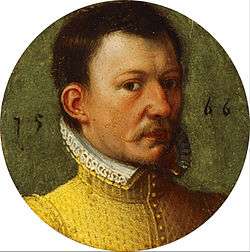Scottish National Portrait Gallery
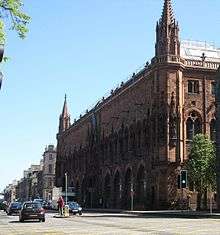
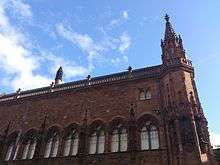

The Scottish National Portrait Gallery is an art museum on Queen Street, Edinburgh. The gallery holds the national collections of portraits, all of which are of, but not necessarily by, Scots. In addition it also holds the Scottish National Photography Collection.
Since 1889 it has been housed in its red sandstone Gothic revival building, designed by Robert Rowand Anderson and built between 1885 and 1890, donated by John Ritchie Findlay, owner of The Scotsman newspaper. The gallery reopened on 1 December 2011 after being closed since April 2009 for the first comprehensive refurbishment in its history, which was carried out by Page\Park Architects.[1]
History
The founder of the Society of Antiquaries of Scotland (1780), David Erskine, 11th Earl of Buchan, formed a collection of Scottish portraits in the late 18th century, much of which is now in the museum. In the 19th century, the Scottish historian Thomas Carlyle was among those calling for a Scottish equivalent of the very successful National Portrait Gallery, London, established in 1856, but the government in London refused to fund the venture. Eventually John Ritchie Findlay stepped in and paid for the entire building, costing £50,000.[2]
The museum was established in 1882, before its new building was completed. The London National Portrait Gallery was the first such separate museum in the world, however it did not move into its current purpose-built building until 1896, making the Edinburgh gallery the first in the world to be specially built as a portrait gallery.[3] Special national portrait galleries remain a distinct Anglophone speciality, with the other more recent examples in Washington DC (1968), Canberra, Australia (1998), and Ottawa, Canada (2001) not so far copied in other countries. The famous collection of portraits housed in the Vasari Corridor in Florence remains only accessible to the public on a limited basis.
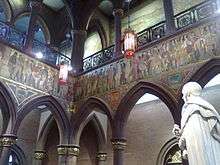
The building was opened in 1889 under curator John Miller Gray, and compensated for the lack of contemporary portraits of medieval Scots by including several statues on the exterior, and in the main entrance hall a large mural processional frieze of notable Scots, from Saint Ninian to Robert Burns. These were added over the years after the opening, with the sculptures by William Birnie Rhind added in the 1890s and William Hole painting the entrance hall frieze in 1898, and adding further large mural narrative scenes on the 1st floor later.[4] The building is in red sandstone from Corsehill from Dumfriesshire, with a combination of Arts and Crafts and 13th-century Gothic influences, and drawing on the Doges Palace in Venice for its treatment of a rectangular Gothic palace.[5]
| Wikinews has related news: A portrait of Scotland: Gallery reopens after £17.6 million renovation |
Over the years new facilities such as a shop and café were added in a piecemeal fashion, and the galleries rearranged and remodelled, generally reducing the clarity of the layout of the building, and often the ceiling height, as well as blocking off many windows. The building was shared with the National Museum of Antiquities, now the Museum of Scotland, until they moved to a new building in 2009, at which point the long-planned refurbishment of the Portrait Gallery could begin, with funding from the Scottish Government and the Heritage Lottery Fund, amongst others. The work generally restores the gallery spaces to their original layout, with areas set aside for education, the shop & café, and a new glass lift—greatly improving access for disabled visitors. In total the Portrait Gallery has 60% more gallery space after the changes, and at the reopening displayed 849 works, of which 480 were by Scots. The cost of the refurbishment was £17.6 million. The entire building comprises 5672 Sq. metres, and is a listed building in Category A.[6] Administratively, the museum comes under National Galleries of Scotland, and shares their website amongst other facilities.
Collection
The museum's collection totals some 3,000 paintings and sculptures, 25,000 prints and drawings, and 38,000 photographs.[7] The collection essentially begins in the Renaissance, initially with works mainly by foreign artists of Scottish royalty, nobility, and mainly printed portraits of clergymen and writers; the most notable paintings were mostly made on the Continent (often during periods of exile from the turbulent Scottish political scene). As in England, the Scottish Reformation all but extinguished religious art, and until the 19th century portrait painting dominated Scottish painting, with patrons gradually extending down the social scale. In the 16th century most painted portraits are of royalty or the more important nobility; the oldest work in the collection is a portrait of James IV of Scotland from 1507.[8]
The collection includes two portraits of Mary Queen of Scots, although neither dates from her lifetime; one was painted some 20 years after her death in 1587, and the other is later still; there are also a number of 19th-century paintings showing scenes from her life. Mary's circle is actually better represented by portraits from the life, with her three husbands all having portraits, including Darnley by Hans Eworth and an unknown painter, and miniatures from 1566 of Bothwell and his first wife. There is a portrait of Mary's nemesis, Regent Morton, by Arnold Bronckhorst who was from 1581 the first artist to hold the title of "King's Painter" in Scotland, though he only spent about three years there. The gallery holds several works by Bronckhorst and his successor, Adrian Vanson; both were skilled painters in the Netherlandish tradition.[9]
The collection includes portraits by Bronckhorst and Vanson of James VI and I, but the others were made after he succeeded to the English throne and moved to London, where the many portraits of other Stuart monarchs were also mostly painted. The first significant native Scot to be a portrait painter, George Jamesone (1589/90-1644) only once got the chance to paint his monarch, when Charles I visited Edinburgh in 1633. The collection includes two Jamesone self-portraits and portraits of the Scottish aristocracy, as well as some imagined portraits of heroes of Scotland's past.[10] There are three portraits by Jamesone's talented pupil John Michael Wright and ten aristocratic portraits by Sir John Baptist Medina, the last "King's Painter" before the Act of Union 1707.[11]
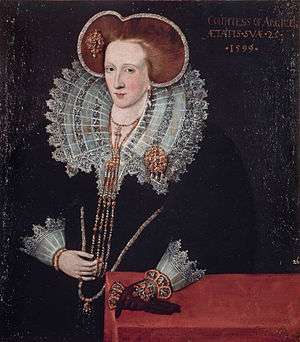 Adrian Vanson, Agnes Douglas, Countess of Argyll, 1599
Adrian Vanson, Agnes Douglas, Countess of Argyll, 1599 Mary, Queen of Scots, posthumous portrait, c. 1610
Mary, Queen of Scots, posthumous portrait, c. 1610 George Jamesone, self-portrait, c. 1642
George Jamesone, self-portrait, c. 1642%2C_1668_-_1700._Son_of_1st_Marquess_of_Atholl_-_Google_Art_Project.jpg) John Michael Wright, Lord Mungo Murray in plaid, 1683
John Michael Wright, Lord Mungo Murray in plaid, 1683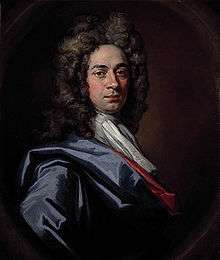 John Baptist Medina, self-portrait, 1698
John Baptist Medina, self-portrait, 1698
The display "Blazing with Crimson: Tartan Portraits" (until December 2013) concentrates on portraits featuring tartan, which begin to be painted in the late 17th century, at that time apparently with no political connotations. The museum has one of the earliest examples, a full-length portrait of 1683 by John Michael Wright of Lord Mungo Murray, son of John Murray, 1st Marquess of Atholl, wearing a belted plaid for hunting.[12] The wearing of tartan was banned after the 1745 Jacobite Rebellion, but reappears in grand portraits after a few decades, before becoming ever more popular with Romanticism and the works of Sir Walter Scott. Also wearing tartan is Flora MacDonald, painted by Richard Wilson in London after her arrest for helping Bonnie Prince Charlie to escape after the 1745 Jacobite Rebellion.
Scottish portrait painting flourished in the 18th century and Allan Ramsay and Sir Henry Raeburn are well represented with 13 and 15 works respectively,[13] the former with many paintings of figures from the Scottish Enlightenment, as well as the recently acquired lost portrait of Charles Edward Stuart, and the career of the latter extending into the 19th century with portraits of Walter Scott and others. The museum owns the iconic portrait of Robert Burns by Alexander Nasmyth. The largest number of works by a single artist is the 58 by the sculptor and gem-cutter James Tassie (1735–1799), who developed a distinctive format of large fired glass paste (or vitreous enamel) relief "medallion" portraits in profile, initially modelled in wax. His subjects include Adam Smith, James Beattie and Robert Adam. Adam disliked having his portrait taken but Tassie was a member of his social circle he did not refuse, with the result that, as with the Naysmyth portrait of Burns, almost all images of Smith derive from the exemplar in the museum.[14]
- Richard Wilson, Flora Macdonald, 1747
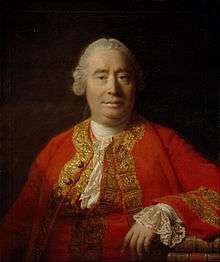 Allan Ramsay, David Hume, 1766
Allan Ramsay, David Hume, 1766.jpg) Hugh Douglas Hamilton, "Bonnie Prince Charlie" in later life, 1775
Hugh Douglas Hamilton, "Bonnie Prince Charlie" in later life, 1775 Robert Burns by Alexander Nasmyth, 1787
Robert Burns by Alexander Nasmyth, 1787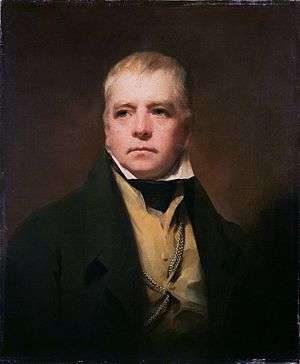 Henry Raeburn, Sir Walter Scott, 1822
Henry Raeburn, Sir Walter Scott, 1822
The later 19th century in Scotland had no such dominant figures, but many fine artists, and saw the beginning of photography. The museum devotes a gallery to the photographs of Glasgow life taken by Thomas Annan, especially the images of slums taken in 1868–71, and in general the displays concentrate on the common people of Scotland. The collection continues to expand in the present day, with Scottish painters such as John Bellany (Peter Maxwell Davies, self-portrait and Billy Connelly) and John Byrne, whose works include images of himself, Tilda Swinton, Billy Connelly and Robbie Coltrane.[15]
Other works in the collection include:
- James Hamilton, 1st Duke of Hamilton, by Daniel Mytens
- Douglas Douglas-Hamilton, 14th Duke of Hamilton, by Oskar Kokoschka
- Winnie Ewing by Norman Edgar
- Alex Ferguson by David Mach
- Ian Wilmut by Wendy McMurdo
- Robin Jenkins by Jennifer McRae
Notes
- ↑ MGS website, "Portrait of a Nation"
- ↑ Press, "Facts and Statistics" and "The History of the Scottish National Portrait Gallery"; History & Architecture, NGS
- ↑ Press, "The History of the Scottish National Portrait Gallery"; History & Architecture, NGS
- ↑ Portrait, 12–13
- ↑ Press, "The History of the Scottish National Portrait Gallery"; History & Architecture, NGS
- ↑ Portrait, 9–10; Press, Facts and Statistics
- ↑ Press, Press release, p. 1, (not yet online here)
- ↑ Press, "Facts and Statistics"
- ↑ MGS website online collection (also includes Scottish National Gallery) for Vanson and Bronckorst
- ↑ MGS website online collection (also includes Scottish National Gallery) for Jamesone
- ↑ MGS website online collection (also includes Scottish National Gallery) for Medina
- ↑ MGS, Lord Mungo Murray [Am Morair Mungo Moireach], 1668–1700. Son of 1st Marquess of Atholl, about 1683
- ↑ Press, "Facts and Statistics", see also MGS website online collection (also includes Scottish National Gallery) for Raeburn, and Ramsay
- ↑ Press, "Facts and Statistics", see also MGS website online collection (also includes Scottish National Gallery) for Tassie and Adam Smith
- ↑ MGS website online collection (also includes Scottish National Gallery) for John Bellany and John Byrne
References
- "Portrait"; Portrait of the Nation, An Introduction to the Scottish National Portrait Gallery, (no author given), 2011, Scottish National Portrait Gallery, ISBN 978-1-906270-37-7
- "Press"; Press pack for the reopening in December 2011
External links
-
 Media related to Scottish National Portrait Gallery at Wikimedia Commons
Media related to Scottish National Portrait Gallery at Wikimedia Commons - National Galleries of Scotland website
Coordinates: 55°57′19.5″N 3°11′36.9″W / 55.955417°N 3.193583°W
